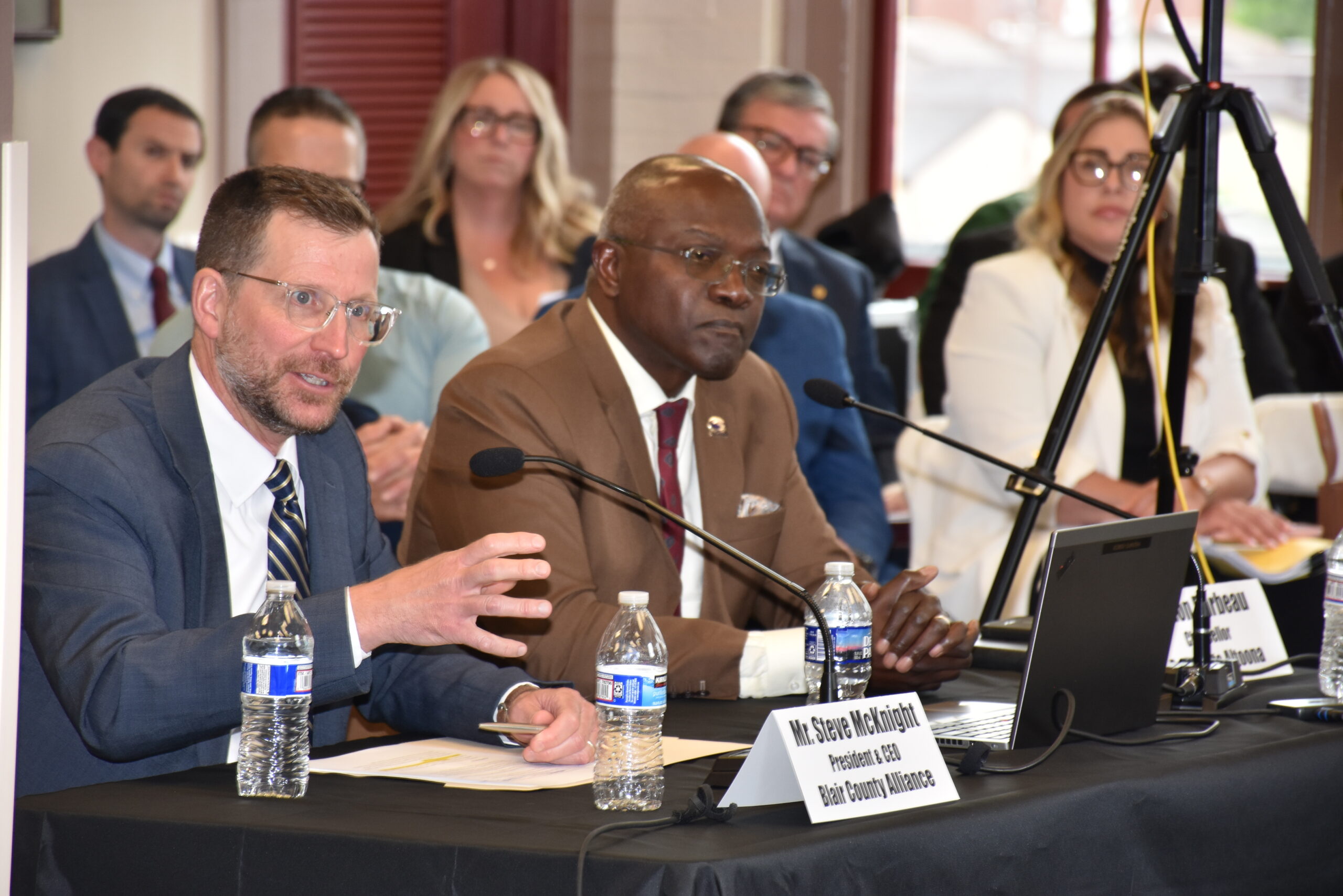PENNSYLVANIA STATE SENATE TRANSPORTATION COMMITTEE TESTIMONY
MAY 28, 20025
PROVIDED BY:
STEPHEN MCKNIGHT, PRESIDENT AND CEO
THE ALTOONA BLAIR COUNTY DEVELOPMENT (ABCD) CORPORATION
ABCD CORPORATION IS AN AFFILIATE MEMBER OF
THE BLAIR COUNTY ALLIANCE FOR BUSINESS AND ECONOMIC GROWTH
_____________________________________________________________________________________________________________________________
On behalf of the Board of the Blair Alliance for Business and Economic Growth, I want to thank Committee Chair Senator Ward and the members for this opportunity to provide testimony on the critically important issue of transportation here in Blair County.
Here in Blair County, we are a community firmly rooted and dependent on transportation. From our original waterways and towpaths to the Pennsylvania Canal and the evolution of rail, the interstate highway system, our economy and our history is based on the movement of goods and services over the great Allegheny Front. It’s why we exist as a community.
Our transportation network allowed our economy to diversify, making us more resilient. Over the years, we have become more insulated from dramatic economic downturns. While we have benefited from major transportation investments, we do not take it for granted. Today, our transportation goals are less about building more and more about maintaining what we have while ensuring our transportation infrastructure in all its forms is relevant and in demand for future generations to come.
Working in partnership with the Blair County Chamber’s Transportation Committee, I would like to offer the following 5 areas of focus for our regional transportation system priorities.
Maintenance: Preserving and extending the life of our existing infrastructure must remain a top priority. Well-maintained roads, bridges, and transit facilities ensure safe and efficient travel, reduce long-term costs, and reflect our commitment to responsible stewardship of public investments.
Rail Safety/Training: As rail traffic continues to play a critical role in freight movement and economic activity in our region, we must prioritize the safety of rail crossings, modernize outdated infrastructure, and enhance coordination with freight operators to prevent accidents and improve community safety. Training next generation rail engineers is also a priority, and one that Penn State Altoona, in partnership with the Railroaders Museum, is taking head on with its nationally recognized Rail Transportation Engineering program.
Rural Air Connections: Rural air service offers critical connectivity for many communities in our region. Supporting reliable and affordable air connections ensures access to broader markets, healthcare, education, and tourism opportunities, helping rural areas remain competitive and connected. We applaud the Blair County Airport Authority for the work they are doing to provide higher value connections, most recently to Charolette, North Carolina which has enplanements increasing and growing every week.
Active Transportation: Walking and biking are essential components of a balanced transportation network. Expanding and maintaining trails of all types, bike lanes, and pedestrian pathways enhances quality of life, promotes public health, and supports sustainable, low-impact mobility options for all residents. Our largest recreational opportunity is a proposed multi-use trail network above the Horseshoe Curve. The property is owned by the Altoona Water Authority. The funding is being sought through the State’s Acid Mine Land Economic Revitalization (AMLER) grant program with the PA Environmental Council serving as the applicant. Moving forward, this is a key economic development priority, helping us attract new residents and investment to our community.
Complete Streets: Designing streets for all users—drivers, transit riders, pedestrians, and cyclists—ensures safety, accessibility, and mobility across age and ability levels. These elements help calm traffic and achieve an overall goal of matching the right scale and type of infrastructure with the right context. Complete Streets policies reflect a holistic approach to transportation planning, where inclusivity and community needs are front and center.
These five focus areas shape our overarching transportation goals. However, in the near term, several pressing maintenance priorities demand immediate attention. While much of our region’s major transportation infrastructure remains in relatively good condition by standard metrics, our partners at PennDOT have identified a growing concern: a significant portion of these assets are now considered “out of cycle.” This means essential treatments and repairs have not been performed within the recommended timeframes.
As infrastructure continues to age, the rate of deterioration accelerates, especially as assets approach the end of their lifecycle. Compounding this issue is the steep rise in material and construction costs, which has placed significant pressure on existing budget levels. While this challenge is not unique to our region, the Central Pennsylvania area faces two particularly critical concerns:
Major Bridge Assets
PennDOT District officials report that state-owned bridges in our region have an average age of just over 50 years. Alarmingly, many of the largest and most structurally significant bridges are now over 70 years old, beyond their intended design life. The cost to replace even a single one of these structures vastly exceeds the region’s typical annual allocation. This concern extends to locally owned bridges as well, including several large structures within Blair County that are approaching or have surpassed their usable lifespan.
Secondary Road System
Most of the region’s primary roadways were constructed during the 1950s and 60s. Naturally, a large share of our current funding must be directed toward the upkeep of these high-priority assets. Unfortunately, this leaves limited resources for the rest of our road network, including many well-traveled secondary routes. One example is PA Route 164, which connects Roaring Spring to Martinsburg and serves as a primary access route to Blair County’s Airport. This critical corridor, which handles approximately 10,000 vehicles daily, has not been resurfaced since 2004 and is now classified as out of cycle. Due to current funding limitations, there are no resources available for full resurfacing. This is just one of several such examples PennDOT has identified across our region.
In closing, Blair County’s past, present, and future are undeniably tied to the strength and adaptability of our transportation system. The areas of focus and the challenges outlined in this testimony are not merely infrastructure concerns; they are economic, safety, and quality-of-life imperatives for the people who live and work here.
We are proud of the investments made to date and the collaborative efforts underway with PennDOT, local governments, and our community partners. However, the issues we face—particularly regarding aging bridges and underfunded secondary roadways—require sustained attention, targeted funding, and proactive planning at the state level.
We urge the committee to continue advocating for equitable, needs-based transportation funding that recognizes the unique demands of regions like ours. With the right support, Blair County can continue to build on its proud transportation legacy and ensure our infrastructure remains a catalyst for economic growth, public safety, and regional connectivity for generations to come.
Thank you again for the opportunity to share our perspective. We look forward to a continued partnership in advancing transportation solutions for Blair County and the Commonwealth.
FOR MORE INFORMATION ON THE TRANSPORTATION TESTIMONY, VISIT THE ALTOONA MIRROR HERE: https://bit.ly/4jkwcd3
FOR THE FULL VIDEO OF THE TESTIMONY, CLICK HERE: https://bit.ly/45viW1S



